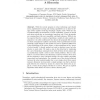ATAL
2008
Springer
14 years 2 months ago
2008
Springer
For robots to become prevalent in human environments, the robots need to be able to perform complex tasks often involving sequential repetition of actions. In this work, we presen...
GECCO
2010
Springer
14 years 2 months ago
2010
Springer
Evolving multiple robots so that each robot acting independently can contribute to the maximization of a system level objective presents significant scientific challenges. For e...
ANTSW
2008
Springer
14 years 2 months ago
2008
Springer
We implement a self-organized flocking behavior in a group of mobile robots and analyze its transition from an aligned state to an unaligned state. We briefly describe the robot an...
ALGOSENSORS
2008
Springer
14 years 2 months ago
2008
Springer
With the current progress in robot technology and related areas, sophisticated moving and sensing capabilities are at hand to design robots capable of solving seemingly complex tas...
AAAI
2007
14 years 2 months ago
2007
This report describes the robot, Curious George, that took part in, and won, the robot league of the 2007 Semantic Robot Vision Challenge (SRVC), held at the AAAI’07 conference ...
AAAI
2008
14 years 2 months ago
2008
With the aim of fluency and efficiency in human-robot teams, we have developed a cognitive architecture based on the neuro-psychological principles of anticipation and perceptual ...
AAAI
2007
14 years 2 months ago
2007
How should a robot represent and reason about spatial information when it needs to collaborate effectively with a human? The form of spatial representation that is useful for robo...
ICRA
1995
IEEE
14 years 4 months ago
1995
IEEE
— Few robot tasks require as forceful an interaction with the world as excavation. In order to effectively plan its actions, our robot excavator requires a method that allows it ...
ICCV
1995
IEEE
14 years 4 months ago
1995
IEEE
The lure of using motion vision as a fundamental element in the perception of space drives this effort to use flow features as the sole cues for robot mobility. Real-time estimat...
MICCAI
2000
Springer
14 years 4 months ago
2000
Springer
A magnetic resonance (MR) compatible surgical assist robot system under preclinical evaluation is described. It is designed to coexist, and cooperate, with a surgeon, and to positi...




